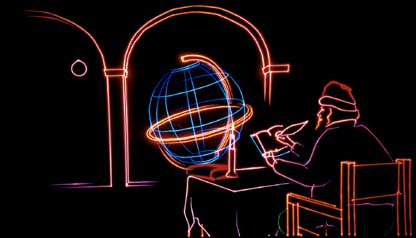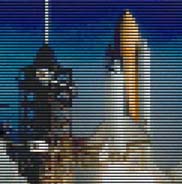How
Laser Shows Work - Graphics System
Graphics systems are usually computer
based and allow for the storage of words, pictures and animations for
projection by the laser scanning system.

Laser graphics from the "Chronology"
show - Photo courtesy of LOBO
Types
of displays
The type of image
display we are most familiar with in everyday life is the the CRT
(Cathode Ray Tube) or LCD (Liquid Crystal Display) which
is found in TV sets and computer monitors. This is a raster
type of display as the information is displayed by drawing a series of
closely spaced horizontal lines very rapidly and varying the brightness and colour of
the pixels in the lines. This type of display requires very high
bandwidth as there is lots of information in the image.
The other most common type of display is a vector
display. This requires lower bandwidth as only the end points
and changes in the line direction are stored. You may have seen
this kind of display in some older video games like Asteroids and
Tempest. In a vector image, the picture is stored as a series of
points and lines are drawn between the points - like a "connect
the dots" picture. If you run through the points in the
image fast enough, the eye is tricked by it's persistence of vision
into seeing a picture rather then the points that make up the image.
As we saw on the Scanning
Systems page, laser images are crated by the mechanical movement
of tiny mirrors. The scanning system can not move fast enough to
give a TV quality raster image so laser systems use vector
images. Even laser systems that are projecting raster like
images are using vector technology to simulate a raster image.
Laser systems draw mostly outline images with no filled or shaded
parts.
|

|
|
Unicorn laser
animation
(This is a .gif representation made from laser frame data, not
actual photos of the laser image)
|
Laser
Graphics
Most graphics systems use point plot
sequential frame animation for graphics storage. This means that the
images are stored as a series of points (like a connect-the-dots
picture), and that animation frames are played back in sequence to
create the illusion of motion as in a cartoon. The points
that make up the image are converted by Digital to Analogue Converters
(DACs) or a display processor in the computer into analogue voltages that drive
the scanning system.
The scanners use small mirrors
mounted on galvanometers at right angles to each other to control the
vertical and horizontal deflection of the beam. The points in the image are refreshed
(re-drawn) many times a second by the scanners so that your eye is
tricked into seeing an image - typical refresh rates are between 18
and 22 Hz. The rapid projection of a sequence of
slightly different images gives the illusion of movement just as in
traditional cell animation (cartoons).
 |
 |
 |
 |
 |
 |
 |
 |
 |
 |
| Ten
of the Key frames from the Unicorn animation shown above. These key frames were combined with "tween"
frames to create the unicorn running (this is a .gif
representation made from laser frame data and not actual
photos of the laser image) |
There are many and varied graphics
systems from the older technology types that store image data on
PROM's, to the newer multitasking real-time 3D systems with dedicated
display processors that store laser images and animations on disk drives. The latest
generation of graphics software uses vector storage where only the
corners or angle changes in lines are stored (rather then every point
in the image), in between points are calculated by the computer in real time as the frames is displayed.
Computer storage and playback of laser
graphics and animations gives the highest image quality. The graphics and
animations are always first generation as they have been produced from the
digital data on site. Modern ADAT based tape storage systems allow for
complex colour laser shows to be digitally recorded onto tape with minimal
image distortion. In some planetarium based laser shows the majority of
the show is recorded onto tape to insure a high quality, consistent
display each time.
| Laser Raster
Graphics
Laser projection
systems can project low resolution rater type images. This
is accomplished by scanning the laser beam back and forth in a
series of closely spaced lines. The colour information is
changed as the beam moves along each line so as to display a TV
like raster image. The scanning system is not fast enough to
project more than 60 to 80 lines so the images are low resolution
and have to be kept small to achieve close spacing of the lines. |

Photo courtesy of
Pangolin
|
Artwork
The process of making laser
animations usually begins with the preparation of artwork. Each individual
frame is usually drawn on paper or sometimes on a computer system. Each frame
must then be hand digitised into the laser graphics system either by means
of a digitising pad/tablet or with a mouse. To create one second of
quality animation, the artist must draw 15 to 20 frames and the digitiser must
convert them to to laser data. Since it can take up to half an hour to
hand create one frame of animation, one second of animation on the screen represents
about 7 to 9 hours of work.

Laser animation of a couple dancing
Courtesy of LaserAnimation Sollinger GmbH,
Germany
Some computer animation tricks can be used such as generating 'tween'
frames. In this process, two frames of a character in slightly different
positions are provided to the computer which generates a third frame that
is the average of the two. Other techniques include cycling a short
animation as it is panned across the screen [for example a man running or
the Unicorn shown above]. This gives the illusion that the animation
is more complex as it occupies more screen area. Laserists can also combining simple short background animations with a more
detailed foreground animation to create a more complex image.
Laser
3D
There are two main types of laser
3D image projection;
Database 3D, and
Stereoscopic 3D
Database 3D
In Database 3D, an image with
three dimensions is created in the computer system either by hand drawing
or importing data from other computer 3D programs. The image can then be
rotated, scaled and displayed with perspective and 'Back clipping'.
With more advanced systems, "image masking" is used to remove
parts of objects that fall behind other objects to enhance the 3D
illusion.
It is
still a flat 2D image projected onto a surface but the image follows the
rules of 3D and fools the eye into believing it is seeing a 3D image -
this is a similar process to that used to make 3D logos and objects on
TV. No
glasses or special viewing equipment is required to see database 3D
images.
Stereoscopic
3D
In Stereoscopic 3D, two slightly different
images of the object,
called views, must be projected, one for the left eye and one for the right eye
version of the object. Often
only one object is created and the computer system then calculates the two
different views to be projected in real time.
When the show is projected, generally two scanning systems (and
sometimes two laser projectors) must be used; one to project the left eye
view and one to project the right eye view. These images are separated by
glasses worn by the spectators to deliver the correct image to each eye.
The eye sees the two slightly different flat images and the brain
integrates them into a full 3D image.
The two most common techniques in use are Anaglyph and orthagonally
polarized 3D. Anaglyph 3D uses glasses with a red filter and a blue
filter. The images are projected in red and blue so full colour
images are not possible.
Orthogonal 3D uses polarized lenses that are set at
right angles to each other. The left eye image is polarized at right
angles to the right eye image so that the glasses pass only the appropriate
image to each eye. The polarized lenses appear light gray and do not
interfere with colour perception allowing full colour 3D images to
be projected.
[
Laser
and exciter | Projector
| Scanners | Control
console | Graphics system
| Outboard Equipment ]